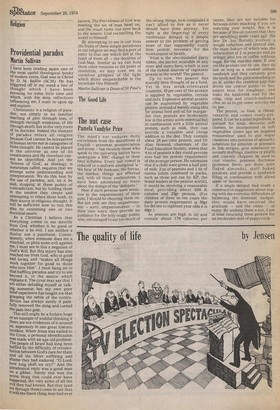The nut case
Pamela Vandyke Price
The mind's ear endures daily excoriation from the distortions of English grammar, pronunciation and stress but recently those who speak to the quivering nation have undergone a BBC change in their final syllables. Every last vowel is reduced to a uniform aboriginal `u.' We hear of Mr Jenkuns, the forcus, the markut, things are effectud and, with all these conferunces, I have been astonished to learn about the doings of the tleleguts.'
Now if such persons were attentive to the requirements of their guts, I should be cheering them on. But not only are they ungastronomic sorry, ungastronomuc in their own ways, they provide no guidance for the telly-soggy public who, encouraged to eat too much of
the wr‘ ong things, now complains it can't afford to live as it never should have done anyway. Yet right at the fin ger-t up of every conferunce delegut is a simple answer to the problem of getting more of that supposedly costly item, protein, necessary for the maintenance of health.
What is the unconsidered party nibble, the packet available in any store and many bars, which is one of the richest sources of vegetable protein in the world? The peanut, Up to now, the peanut has scarcely been thought of as a food. Yet in less steak-orientated countries, 85 per cent of the protein is supplied by vegetables, cereals and nuts. Expensive animal protein can be augmented by vegetable protein, instead of merely using this for animal feed and oil for margarine; true, peanuts are moderately low in the amino acids essential but in combination with a little animal protein, such as milk, they can provide a valuable and cheap addition to the diet. They contain about 28 per cent protein, and Dr Alan Howard, chairman of the Food Education Society, states that 4 oz of peanuts a day could provide over half the protein requirement of the average person. He estimates that if a child were given a half pint of milk, 2 oz of peanuts and 1 oz of raisins (often combined in packs, such as those put out by KP, the brand leaders in the peanut world), it would be receiving a reasonable meal, providing about 600 K calories and 25gr protein. (For children of three to ten years the daily protein requirement is 30gr for the ten to eighteen year olds it is 60gr,) As peanuts are high in oil and contain about 170 calories per
ounce, they are not suitable for between-times snacking if you are watching your weight. But it is because of this oil content that they are satisfying: some years ago, the late Dr Joy Barnett evolved a weight reduction and control diet, the main feature of which was the substitution of 2 oz peanuts and an orange, plus tea or coffee without sugar, for the mid-day meal. If you eat the peanuts one by one, they do last as long as a smoked salmon sandwich and they certainly give the teeth and the guts something to go at, unlike the crustless pap that drives the costive public to buy patent bran for roughage, and make the kiddiwink wail for the crisp, chip and crunch-endowed choc so as to get some activity for its jaw. The peanut, as food, is cheap, versatile and comes ready-prepared. It can be a salad ingredient, a garnish for soup, decorate soft cheeses, be incorporated in soft vegetables (years ago an inspired restaurateur used to put water chestnuts into portions of spinach), substitute for almonds or pinenuts in fish recipes, give substance to savoury stuffings, risottos or pilaffs and, coarsely chopped, be used to coat rissoles, pommes duchesse (pommes Berni are done with flaked almonds), stuff baked potatoes, and provide a sandwich filling, in combination with sliced apple or banana.
If a single delegut had made a constructive suggestion about coping with the everyday difficulties of balancing the domestic budgut, they would have received the gratitude and the votes of many. By wishing them a nut, I am at least returning them protein for an intolerable deal of poppycock.


































 Previous page
Previous page